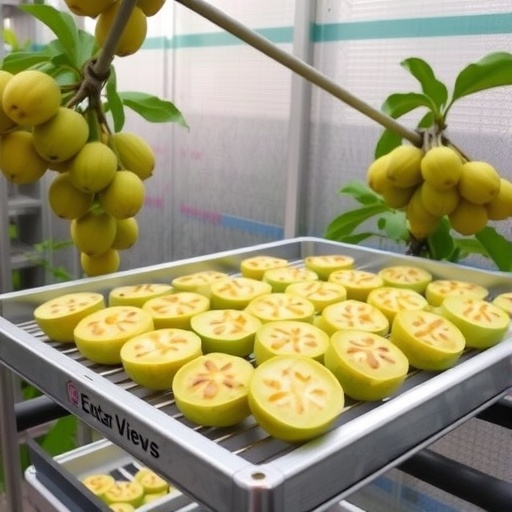In the ever-evolving landscape of food technology, guava drying has emerged as a critical area of innovation, reshaping how this tropical fruit is preserved and utilized globally. The latest comprehensive overview by Verma et al., published in Food Science and Biotechnology in 2025, delves deep into the cutting-edge advancements and trends in guava drying technologies. This work not only maps the technological trajectory but also highlights the critical challenges and solutions that define the modern practice of guava dehydration.
Guava, prized for its rich nutritional profile including vitamin C, dietary fiber, and antioxidants, is highly perishable, making drying an essential process for extending shelf life and broadening its market reach. The review details various drying techniques, emphasizing their impact on maintaining the fruit’s sensory qualities and bioactive compounds. Traditional drying methods such as sun drying, though economically favorable, are often marred by inconsistent drying rates and product quality degradation. Thus, the focus shifts to innovative technological solutions.
One of the standout advancements is the integration of controlled environment drying approaches, such as hot air drying combined with microwave or infrared radiation. These hybrid techniques significantly reduce drying time while preserving nutritional and organoleptic properties. Microwave-assisted drying, for instance, offers rapid heat transfer that can enhance water removal without excessive thermal damage, a breakthrough that promises to revolutionize the commercial processing of guava.
The article also addresses the role of novel pre-treatment methods before drying, such as osmotic dehydration and enzymatic treatments. These approaches improve mass transfer rates during drying and help retain vital phytochemicals. The incorporation of edible coatings and natural preservatives is another promising trend outlined, aiming to inhibit enzymatic browning and microbial spoilage during and after drying.
Beyond the drying methods themselves, the comprehensive review highlights the design and optimization of drying equipment, which is paramount for scaling these technologies industrially. Advancements in computational modeling and control systems allow for precise regulation of temperature, humidity, and air velocity, maximizing drying efficiency and product quality. The development of smart drying chambers equipped with real-time sensors and AI-driven control algorithms exemplifies the cutting-edge integration of Industry 4.0 principles in food processing.
Furthermore, the assessment of energy consumption in guava drying processes is critical, given the global push towards sustainability. Technologies now focus on reducing energy inputs through innovations such as solar-assisted drying systems and the utilization of waste heat recovery systems. These not only lower operational costs but also minimize the carbon footprint, aligning with green manufacturing goals.
From a nutritional standpoint, the review explores how various drying protocols impact guava’s bioactive compounds, particularly vitamin C and polyphenols, which are sensitive to heat and oxidation. Advanced drying techniques preserve these components better than conventional methods, potentially enhancing the health benefits of the dried product. This aspect is increasingly important as consumer demand shifts towards functional foods with validated health claims.
The sensory attributes of dried guava, including texture, color, and flavor, receive considerable attention in the analysis. High-quality dried guava maintains the natural sweetness and aroma of the fresh fruit, attributes that are critical for consumer acceptance. The paper underscores the importance of balancing drying kinetics to avoid case hardening and ensure uniform drying throughout the fruit matrix.
Advances in packaging technologies are also discussed, focusing on materials and coatings that extend the shelf life and preserve the quality of dried guava. Modified atmosphere packaging (MAP) and active packaging with moisture scavengers or oxygen absorbers are highlighted as effective strategies to prolong freshness and prevent spoilage caused by rehydration or microbial growth.
The research incorporates the evaluation of emerging novel drying technologies such as freeze drying and refractive window drying, assessing their feasibility for large-scale production. Freeze drying, despite higher costs, produces superior quality products with minimal nutrient loss. Refractive window drying, a relatively newer technique, offers rapid moisture removal with enhanced retention of sensory and nutritional qualities.
Scientific insights into the kinetics and thermodynamics of guava drying provided in the review are crucial for process optimization. Mathematical modeling assists in predicting drying behavior under various conditions, thereby enabling the fine-tuning of parameters to achieve optimal product yield and quality. These predictive tools are indispensable for researchers and engineers aiming to innovate efficacious drying protocols.
The socio-economic impact of improved guava drying technologies is underscored, especially in regions where guava is a vital agricultural commodity. Enhanced drying methods can significantly reduce postharvest losses, empower local farmers, and stimulate the dried fruit export market. The review posits that technology transfer and policy support are essential to harness the full potential of these innovations at the grassroots level.
Finally, the article paves the way for future research directions, urging interdisciplinary collaboration between food scientists, engineers, and material scientists. The development of multi-functional drying systems that integrate preservation with value addition, such as fortification or flavor enhancement, remains a promising frontier. Simultaneously, addressing scalability challenges and cost-effectiveness will be critical to the widespread adoption of these technological advancements.
In summary, the article by Verma and colleagues represents a seminal contribution to the field of food processing technology, offering a thorough, nuanced understanding of guava drying advances. It combines scientific rigor with practical insights, situating guava drying within the broader narrative of sustainable, quality-centered food preservation. This comprehensive examination not only informs current practice but also inspires future innovation to meet the evolving demands of global food systems.
Subject of Research: Technological advances and trends in guava drying
Article Title: Technological advances and trends in guava drying–a comprehensive overview
Article References:
Verma, K., Nema, P.K., Dadhaniya, H. et al. Technological advances and trends in guava drying–a comprehensive overview. Food Sci Biotechnol (2025). https://doi.org/10.1007/s10068-025-02050-3
Image Credits: AI Generated
DOI: 28 November 2025
Tags: advancements in food preservation methodsbioactive compounds in dried fruitschallenges in guava dehydration processescontrolled environment drying methodsfood technology trends in 2025guava drying technology innovationsguava shelf life extension strategieshybrid drying techniques for guavamaintaining sensory qualities in dryingmicrowave-assisted drying benefitsnutritional benefits of dried guavatraditional vs modern drying methods





